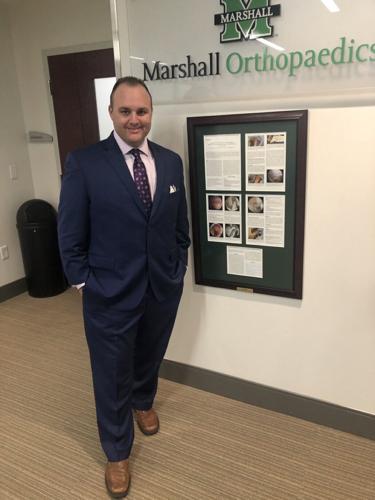In college football, often times the backup long snapper goes unnoticed. However, for this West Virginia University alumni, he is changing the game for the better.

Dr. Chad Lavender was a West Virginia football player from 2000-2003.
Dr. Chad Lavender played at West Virginia from 2000-2003. During his time at West Virginia, Lavender kept seeing teammates getting injured, which is where he developed the passion for what he does now.
“What you saw up close and personal when I was there, I had teammates who would be injured and they would come back, but they would not come back to the level that they were before they got injured before an ACL tear and other injuries,” Lavender said.
Seeing those ACL injuries and the grueling process it took to come back from one, inspired Lavender to create the Lavender Fertilized ACL Procedure.
In this procedure, Lavender was able to create a new way for the ACL to be reconstructed. Lavender used a mixture of bone marrow concentrate and demineralized bone matrix to fill the tunnels within the joint of the knee during reconstruction.
“This procedure, it adds biology to the existing ACL reconstruction; which in theory would help your own body heal faster or more thoroughly,” Lavender said. “It also adds an internal brace which should also and has been proven in the lab to increase your stability of the construct. Because of those two things we think and the theory is that it would improve the results of the reconstruction overall.”
Those results from this procedure have already been seen to work.
“In our clinical trial, the fertilized patients at 12 weeks test at 80 percent of their opposite knee – which is over twice the average for the control group,” Lavender said. “This is a faster return to limb symmetry than a standard ACL reconstruction, which is six to nine months.”
Lavender’s technique of using biology as well as an internal brace is designed to help improve the stability of the ACL to speed up the recovery process.
Owen McClanahan, a football player from Poca High School in W.Va., went through Lavender’s procedure and was springing just eight weeks after his surgery.
“I had a couple buddies that played on our football team and they had ACL tears and they didn’t get back until about six-to-eight months. They were just surprised of how I was already moving, already running, already jumping up and down,” McClanahan said.
Lavender said his goal is to continue to find ways to help these athletes return to their sport and to be as healthy as possible.
“All we’ve done is enhanced and added to the standard ACL,” Lavender said. “The things and the processes that we’ve helped develop and research, are things that can be added to the ACL standard reconstruction and our goal honestly is to figure out how to improve athletes’ recovery by adding biology in the brace and other things to the procedure to try to improve their recovery and improve their return to play and their capabilities post-operatively.”
Lavender currently works at Marshall Orthopaedics, but says his connections at WVU and throughout the state helped mold him into his role today.
“What’s unique about myself is that I work obviously now at Marshall, but played football for WVU, went to medical school there, so I have ties with about everyone in the state. So, I’m not really partial one way or the other and I think that’s really helped the state rally around what we’re doing,” Lavender said.
“That WVU experience was a big part of what molded me. Coach Nehlen and the support staff at WVU really molded me as a student athlete to really put me in a position to get into orthopedics and to succeed like I have at Marshall,” Lavender added.
For Lavender, he is forever grateful for the support he received at WVU, and hopes people realize there is much more to a football program than what is seen on Saturdays.
“Sometimes people are so focused on the premiere athletes and one of the things that sometimes is lost is someone like myself that is a student athlete, that has a great college experience, wasn’t a star athlete, but that’s able to have success and get a great education,” Lavender said. I can’t say enough good things about the whole student-athlete experience I had at WVU. There’s so much more to it than what you see on Saturdays.”
Currently, Lavender has published results of his testing and hopes the medical community can begin to see how groundbreaking his procedure is.
“Out for publication, we have a retrospective analysis of patients that are around three years out from their reconstructions. And those patients had a 94% return to sport,” Lavender said. “We also then have finished our prospective randomized trial, which is 60 patients were enrolled into that. All of those patients are over six months out now. We just submitted the early results of that study as well. Both of those studies have been submitted in the last month.”
As for what is next, Lavender said this procedure is going to begin to be tested on a national level.
“We’re really excited about the next phase of our research which will be a multi-center trial. What that means is about 13-15 sites across the country will be performing the techniques and we’ll be following those patients and athletes over the next two to five years,” Lavender said.
Lastly, Lavender is not fazed by doubters of his procedure, and has welcomed questioning of his technique, as he believes that has enhanced the reconstruction surgery overall.
“With any new technology, process, or technique, you’re going to be criticized or critiqued. This is no different, but honestly some of the best findings we’ve had have been from questions people have asked,” Lavender said.
Lavender added, “I think that for the most part people are welcoming and ask great questions and are interested in the academia in what we’re doing. There have been a few outliers just like with anything else that have been slightly more critical, but I think when you do something like what we’ve done with creating new techniques based on newer technologies you expect that. Critiques or people being critical or not being early adopters hasn’t fazed us in one bit. If anything, it causes us to be even better with our techniques and our research practices.”


















 WVU's Independent Student Newspaper
WVU's Independent Student Newspaper